When we started My Chinese Home Kitchen, I was very excited to start cooking Chinese food at home. I am a foodie, and I like authentic cuisines, especially home recipes. My favorite cuisines are New England, where I was born, Cajun, Mexican, Thai, and Chinese. My tastes are eclectic, and I do enjoy some Italian dishes, especially seafood, and Jamaican, especially Jamaican Jerk. Like many Americans, my knowledge of Chinese food was limited to take out, and a brief time in college back in the 80’s, when I shared a rental house with a Chinese couple. They food they cooked was very different from the offerings at the local takeout place.
Table of contents

Each cuisine has its basics. With New England chowders, for instance, the real thing starts with salt pork. Cajun has the “holy trinity” of onions, bell peppers, and celery, and many dishes start with a roux. I knew nothing about the basics of Chinese cooking. Many of Jing’s first recipes were quite simple, easy to follow, and used readily available ingredients, but I did not even have a wok. I mean, you must have a wok to get started cooking Chinese food at home, right?
First attempts at cooking Chinese
I thought I knew more than I did. Socrates said the beginning of wisdom is the recognition of one’s own ignorance. Well, I got wise fast.
A good cast-iron skillet can substitute for a wok
The first thing I learned was one does not need a wok. A good, deep cast-iron skillet will do. You need one at least 10 inches in diameter. I have always cooked with cast-iron, so I was able to start with the pans I had on hand.

The second thing I learned was the pan does not need to be blazing hot. In fact, hot enough for a drop of water to sizzle and evaporate in 1 or 2 seconds is hot enough. In fact, it’s better, because without the training of a Chinese chef, who can use a wok to toss ingredients quickly over a very hot stove (100,000 BTU or more), a pan that is too hot just incinerates the ingredients.
Chinese cooking techniques
The third thing I learned, when beginning to cook Chinese food at home, was that not every dish is a stir-fry and “stir-fry” is a bad translation. The literal translation is to toss and tumble the ingredients, which makes sense when you watch a Cantonese master chef. In point of fact, the Chinese have many methods of cooking. Stewing, braising, dry-blanching (done with oil at around 212 degrees F), dry-braising, red-braising, simmering, deep-frying, and pan-frying are among the many techniques used. The same foods, such as chicken, can be crispy or tender, depending on the chosen method. If you compare Jing’s Professional Style Kung Pao Chicken and her Kung Pao Chicken, Homestyle, you will find the chicken has a different texture in both dishes, even though the flavor is similar.
Invest in a few quality staples for your pantry
The fourth thing, and the most important lesson, occurred the first time I cooked her Kung Pao chicken. I never added salt, but the dish was too salty to eat. I did some research, and found out my mistake was using a cheap American soy sauce (La Choy). Real soy sauce is fermented for a year. It is naturally salty, but it has a distinctly better flavor than the mass-manufactured chemical concoctions in the US. Before you buy a wok, invest in Premium Soy Sauce. While you are at it, order a few other basic staples, like Chinese Chili Peppers and Sichuan Peppercorn (Huājiāo 花椒). I’ve tried substituting Mexican chile de arbol for xiaomila peppers, but the flavor is not the same.
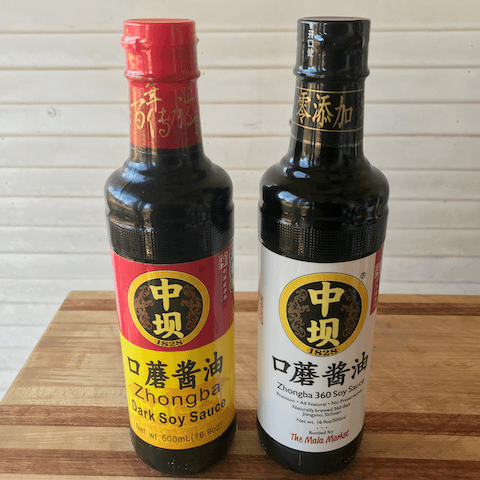
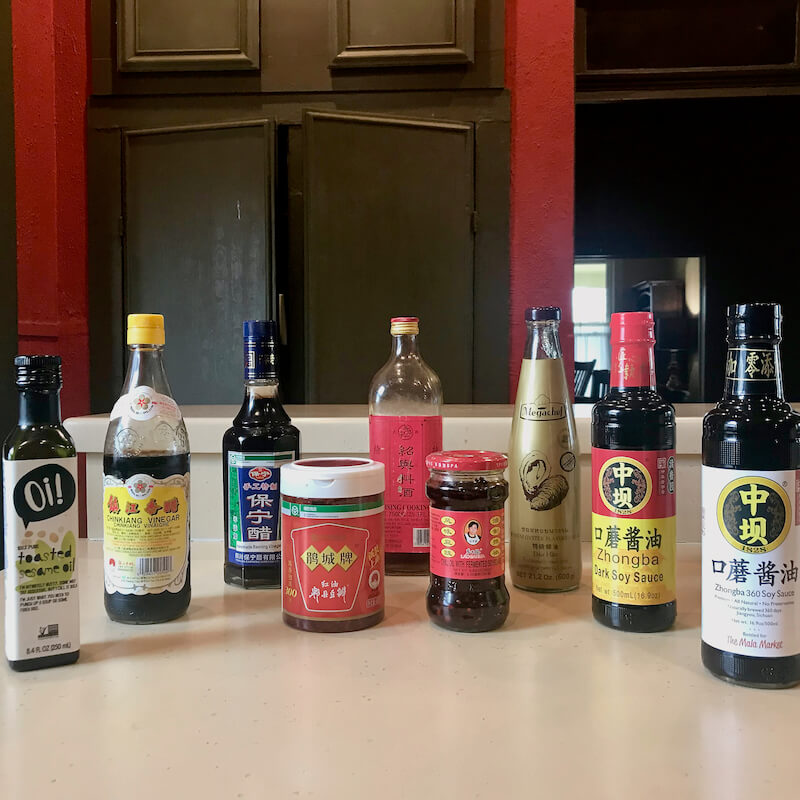

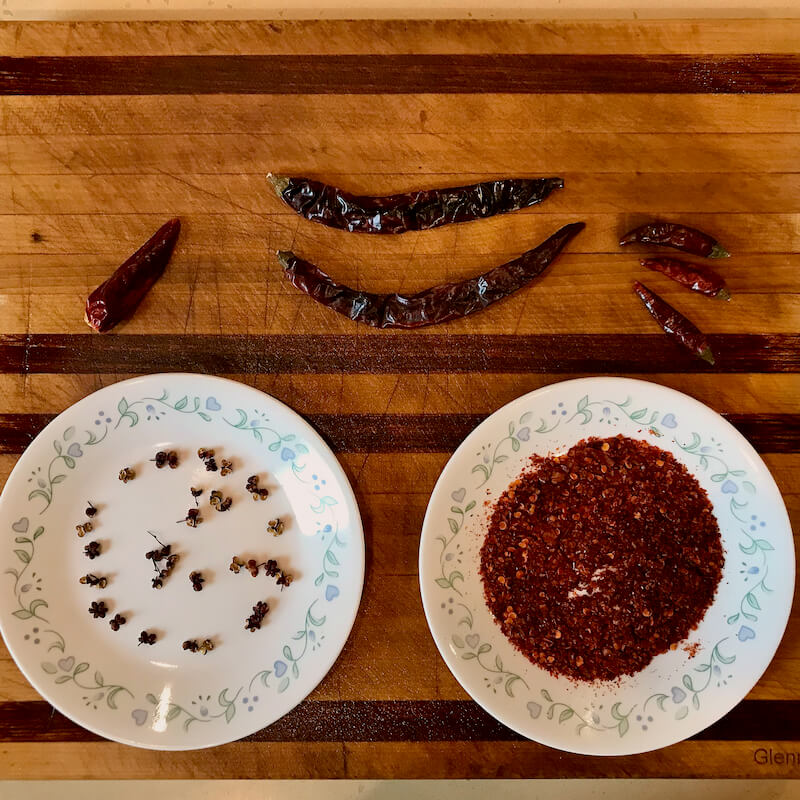
You do not need to spend a lot of money. Investing in a few authentic ingredients with good quality will greatly improve your results.
You can cook most of Jing’s recipes if you keep the following items in your pantry:
- Chinese Chili Peppers
- Chinese Chili Powder
- Sichuan Peppercorns
- High temperature oil (I use Peanut Oil and Caiziyou) for frying
- Authentic soy sauce
- Authentic oyster sauce
- Shaoxing cooking wine (you can substitute sherry)
- Baoning vinegar (you can substitute white vinegar)
- Pixian doubanjiang (red bean paste for Sichuan dishes)
- Laoganma chili oil with black beans (Laoganma uses MSG and some preservatives, if you want all natural, you can try brands like Fly By Jing)
What you need to get started
To cook Chinese food at home, you need either a wok and spatula or ladle, or a good cast-iron skillet. If you have cast-iron cookware, a Dutch oven comes in handy too when deep-frying. Don’t use a non-stick skillet or stainless steel. Non-stick cookware has a toxic coating, and this can get into the food in small amounts. Also, a non-stick pan cannot handle the higher heat when stir-frying. Stainless steel is not non-stick and you will have to use more oil, making the food greasy.
A wok, by its very design, uses less oil than other options, and a good 14-inch wok with a flat bottom is very affordable. If you purchase a wok, look for carbon-steel with a long wooden handle. Cast-iron woks can be heavy, if made in the USA, and take longer to heat. The thinner cast-iron in a Chinese-made wok has great properties for heating, but must be handled with care. The thinner metal can shatter if dropped.
If you don’t have a rice cooker, a saucepan with lid is find for cooking rice. When cooking rice, do not follow the instructions on the bag. Instead see How to Cook White Rice.
Knife and cutting board
You will want a good kitchen knife and cutting board. I use a Western style knife. You can use the same if you have it, or purchase a Chinese vegetable cleaver if you prefer. Keeping your knife sharp is essential. Jing uses a whet stone, because she has practiced this skill since she was a girl. I use an electric, three-stage sharpener set for a 15-degree angle. This finer angle makes precise cutting easier, with a scalpel like edge.
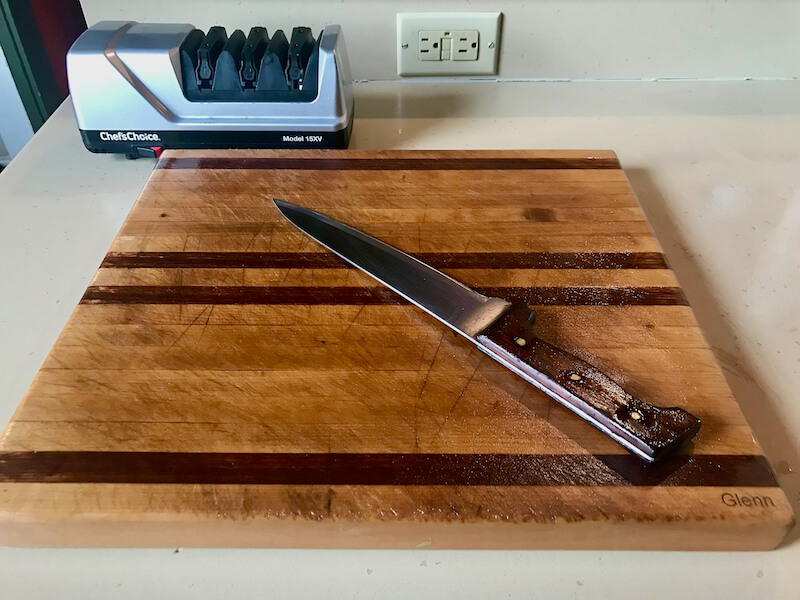
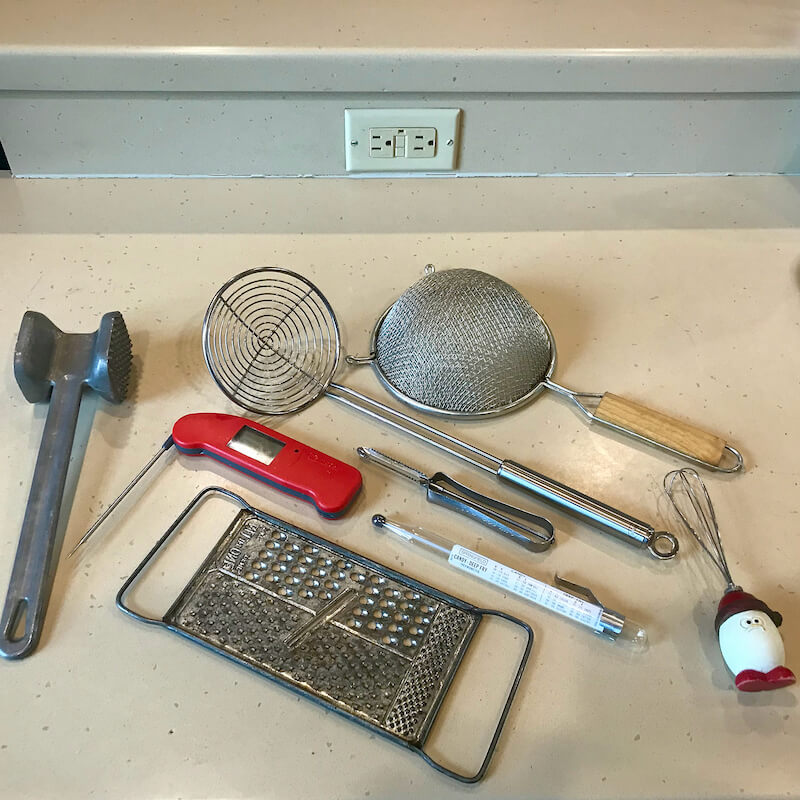
Utensils for working with cooking oil
A wire skimmer is a nice addition, if you do not have one in your kitchen. This is very handy when dry-blanching, deep-frying, or water-blanching ingredients. The skimmer allows you to remove them quickly while letting the oil or water drip back into the pan.
A wire kitchen strainer is useful for filtering oil after cooking, to remove any browned bits of batter or breadcrumbs. If you filter the oil after each use, when it has cooled, it can be reused. Oil used for deep-frying should not be reused more than a few times, and discarded if you heat it to smoking. When oil begins to smoke, its chemical properties begin to change. However, you can get two or three uses of oil used to fry or blanch meat, and four or five uses of the oil used to blanch or fry vegetables. See How to Clean, Reuse, and Dispose of Cooking Oil for more information. If you do your own gardening, used oil makes a good addition to the compost pile. It is organic, and earthworms love it.
Over time, you will learn to judge the temperature of oil. For instance if you insert a chop stick and the oil bubbles around the stick, the temperature is around 300 degrees F. However, I find a quick digital thermometer the best. A candy or deep-fry thermometer can work too, but takes much longer to register the temperature. Holding it in the oil exposes your arm to the heat for a few moments while you wait for the reading.
Other handy utensils
Most of the other tools you probably already have in your kitchen.
A wire whisk for beating eggs and mixing starch water solutions is essential.
A meat hammer is hand for crushing ginger slices or chopping through rib bones. (See Chopping Pork Ribs for Braising or Frying and How to Peel and Mince Ginger.)
I use a hand-held slicer for slicing potatoes. You can also use it for shredding cheese and carrots, but it makes a mush out of cucumbers. For most of my shredding, I use my kitchen knife. However, if you find this tedious or time-consuming, a good mandoline can make your task much easier. Frankly, I prefer the challenge of mastering my knife skills. But as I start to host more dinner parties, I’m thinking of buying a mandoline. I spend several hours chopping and slicing when preparing to cook for a dinner party. I’ll never be as fast as Jing with her knife.

Most recipes call for garlic, and several call for green onions and ginger too. Ginger is used to remove the “fishy” taste, from meat. Ginger also has properties that help tenderize the meat. I don’t use a garlic press. With a little practice, you can be just as fast with a knife: How to Peel and Mince Garlic Quickly.
You probably already have these in your pantry
Corn starch is used in a lot of Chinese dishes. It is used for thickening broth from vegetables to make a glazed coating, and for creating a sauce in several other recipes. This is similar to thickening gravy in Western cooking, but using corn starch instead of flour, and the sauce is not so thick. Corn starch also helps to seal in the juices and flavor of meat before cooking, especially shelled shrimp. Sometimes a recipe calls for sweet potato starch: you can order this online, or do as I do and substitute corn starch.
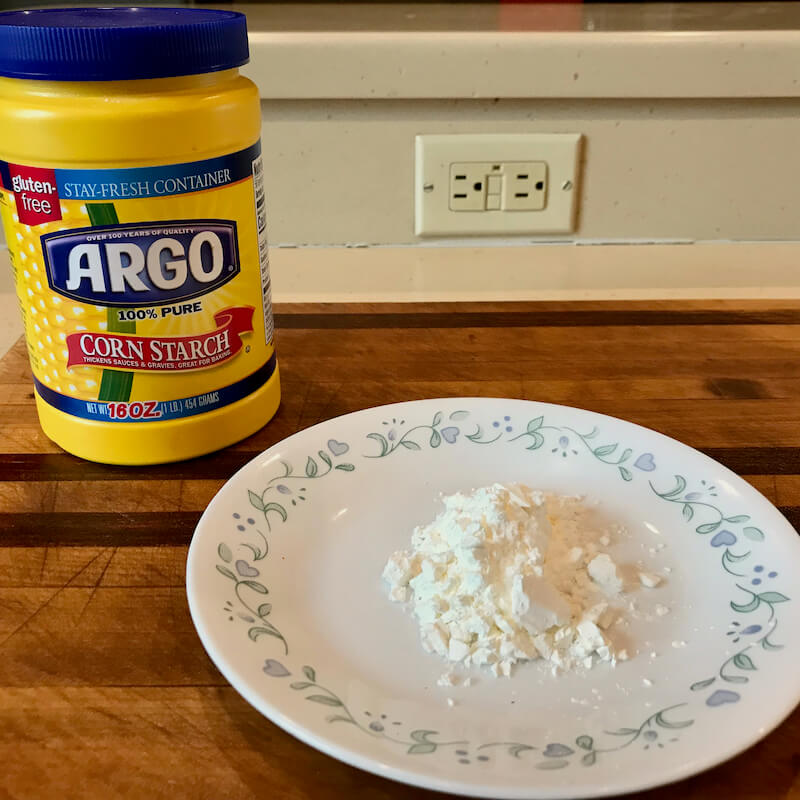

You probably have stick cinnamon in your pantry. We do not use it in many recipes, but it makes a real difference in some.
If you like red-braised pork, kou rou, or hot pot, you’ll want to have some star anise on hand. This has a slight licorice flavor to it, and really goes well with simmered pork belly recipes.
Optional items
Chinese cuisine is often associated with stir-fried dishes, especially Cantonese, but steaming is just as common. Steamed dishes are healthier. Even though wok cooking uses less oil than a flat Western skillet, it still uses oil. Steaming surrounds food with hot moisture and cooks it on all sides at once without any oil. You can steam with a double-boiler, but these are too small for many dishes.
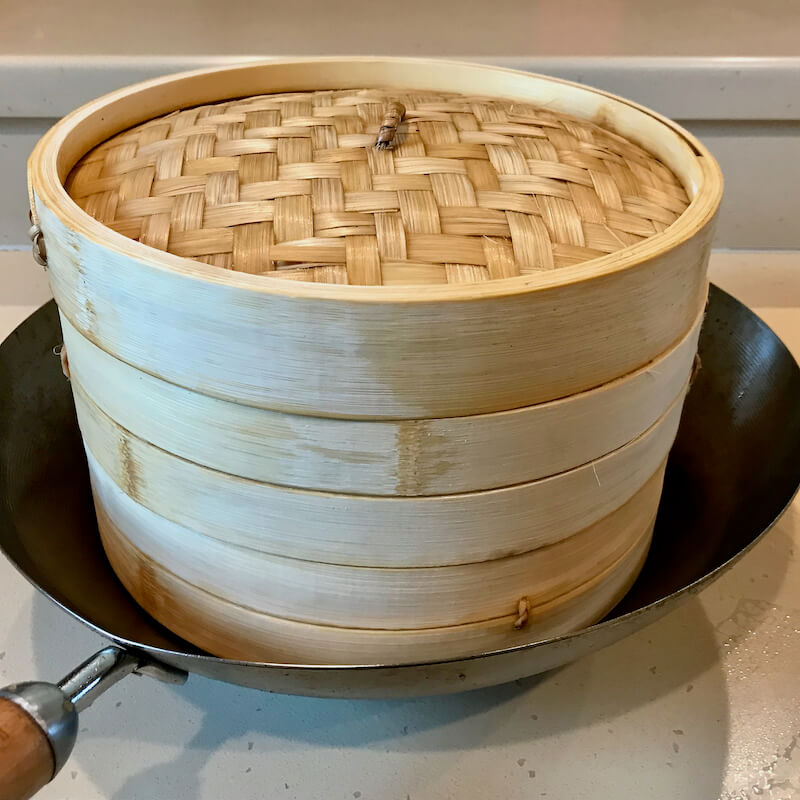

A bamboo steamer, and a wire steam rack for your wok with a domed lid, can open up a whole new world of delicious, healthy eating. From dumplings to fish to Mei Cai Kou Rou, there are many popular steamed dishes.
Related articles
Do you enjoy My Chinese Home Kitchen?
We enjoy sharing these authentic home recipes with you. Learn more about My Chinese Home Kitchen at our About page.
Please leave a comment, or SUBSCRIBE to our newsletter.
For more of our original videos, visit My Chinese Home Kitchen on YouTube and Rumble.


